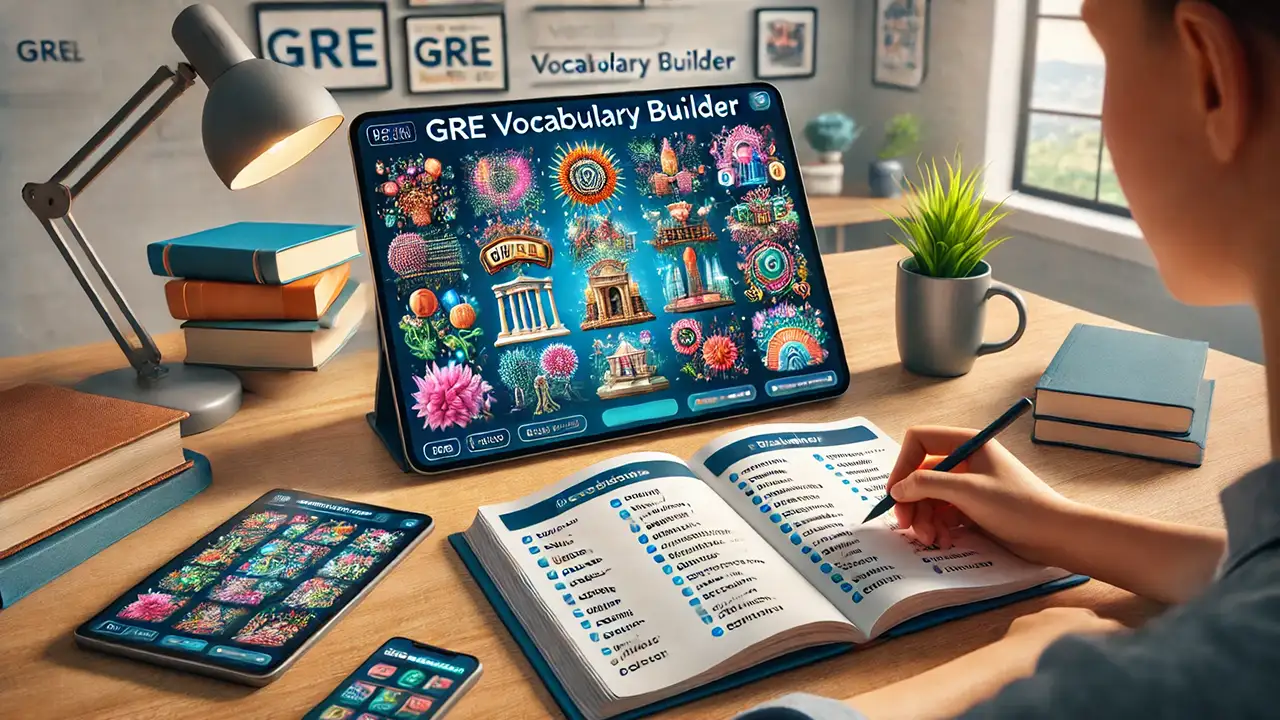
GRE Newsletter Subscribe
Enter your email address below and subscribe to our newsletter

Enter your email address below and subscribe to our newsletter

Let’s face it – memorizing 500-700 new words for the GRE feels like a mountain to climb. But here’s something interesting: you might already know many of these words… or at least think you do. Take the word “deliberate,” for instance. You probably use it to mean “purposeful” or “intentional.” But did you know it has another meaning – “to consider carefully and methodically”? This second meaning is actually more likely to appear on your GRE!
This brings us to an important point: GRE vocabulary preparation isn’t just about learning entirely new words. It’s often about:
Let’s explore the most effective strategies for building this deep understanding.
Your brain remembers things that matter to you. Creating personal associations, or mnemonics, is your first powerful tool for vocabulary retention.
The power of visual associations lies in how our brains process information. Research shows that we remember images far more effectively than abstract concepts – in fact, our brains process visual information 60,000 times faster than text. When you create a mental image for a word, you’re essentially giving your brain a shortcut to recall.
For example, take the word “mercurial” (meaning changeable or volatile). In your mind, you can associate it with mercury in old thermometers, rising and falling rapidly with temperature changes.
Think about it – which is easier to remember: a dictionary definition of “mercurial” or the image of a thermometer’s mercury dancing up and down?
You can also associate the word to someone or something in your life who is prone to volatile mood changes. Have an aunt who gives in to mood swings or temper tantrums? Or maybe a cat that scoffs at you while also seeking attention? The more personal and vivid your association, the better it sticks.
This is especially helpful during the GRE when you need quick word recall under pressure. Creating these visual anchors now means faster, more reliable recall during the test.
If you are not able to form your own personal connections for all the words, what do you do? Wizako’s Vocab Builder provides carefully crafted example sentences from everyday scenarios and AI-generated images that help spark these personal connections.
Let’s take the word “garrulous” (meaning excessively talkative). When you read a sentence like
“The garrulous tour guide animatedly described every minute detail of the monument, leaving tourists yawning, checking their watches, and quietly wandering off in boredom.” – have you been on one such tour? That’s the power of contextual learning at work!
Or consider this: “My garrulous friend transformed every meetup into an epic storytelling session, complete with dramatic pauses and colorful details about her seemingly endless dating adventures.” I bet you’re already thinking, “That’s exactly like my friend Rita!”
Once these vivid mental associations click, they stick. You’re no longer memorizing a word – you’re connecting it to real people and situations from your life. This is precisely why we craft descriptive example sentences to spark these personal connections and provide images to consolidate the mental mapping.
Flash cards are only partially effective in learning words. Isolated definitions rarely stick to your memory. After all, the test presents words in complex sentences and passages. Here’s how to build strong contextual understanding:
Consider how context deepens your understanding. Take the word “vacuous” (meaning mindless or empty). While you might be familiar with the phrase “vacuous stare” from fiction – as in “He sat slumped on the park bench, nursing a broken heart and staring out at the bustling city with a vacuous stare” – the word’s usage extends far beyond empty gazes.
In Wizako’s Vocab Builder, we provide multiple real-world examples for each word, showing how it’s used in business, academic, or everyday situations. This helps you understand the word’s full range of use.
Let’s explore richer contexts you will find in our lesson on “Vacuous”:
This variety of examples prompts an important question: what exactly can be described as “vacuous”? You might wonder, “Could I use it for an empty box?” (Spoiler: you can’t!). This kind of engagement – questioning and testing word usage – is exactly what helps you master vocabulary for the GRE.
When you encounter a Text Completion sentence like “The child opened the gift box and was disappointed to find it _____,” you’ll know that while “empty” fits perfectly, “vacuous” would be incorrect.
A second benefit: when you see four different uses of a word, chances are at least one of them will click with your personal experience. Maybe you’ve watched that mindless reality show, escaped the city’s endless chatter, or read that paper full of empty claims. This is the kind of nuanced understanding that sets apart strong test-takers.
Here’s a fascinating aspect of learning: sometimes, understanding what something is not can be as helpful as understanding what it is. Think about terms like “non-smoker” or “anti-piracy squad” – they’re defined by what they’re not. So, include antonyms as much as synonyms when you learn GRE words.
Take “dogmatic” for example:
Let us illustrate how Wizako’s Vocab Builder prepares you for understanding word relationships in GRE questions.
In our lesson on “dogmatic,” you’ll find not just a list of synonyms and antonyms but carefully crafted sentences like:
“Professor Miller was known for his dogmatic approach to literary criticism; such unbending adherence to traditional interpretations made him dismiss any modern analytical frameworks.” See how the synonymous phrase “unbending adherence” reinforces the meaning?
You’ll also find examples showing contrasts, like:
“My roommate, typically flexible about household matters, becomes oddly dogmatic when it comes to dinner time, insisting that 7 PM is the only acceptable hour to eat.” Here, understanding the contrast with “flexible” deepens your grasp of the word.
After working with such examples, when you face a Sentence Equivalence question like “The teacher’s ______ teaching style, focused on rote memorization and unquestioning acceptance, stifled the students’ natural curiosity and creativity,” you’re not just recalling a definition – you’re recognizing familiar patterns that point to “dogmatic” as one of the perfect fits.
Not all meanings of a word are created equal – at least not for the GRE. Some are more likely to appear on the GRE test than others. This is where strategic learning comes in:
Consider Screed for instance. The word has not one, not two, but three meanings. Wizako’s GRE Vocab Builder will provide you with all three meanings. Will help you understand the context with sentences and images for each of those meanings. But….., will also tell you which of these meanings is/are likely to be tested in the GRE.
The politician’s inflammatory screed, delivered during a contentious town hall meeting, polarized the community and ignited a fierce debate about local zoning laws
The workers poured a screed of concrete over the foundation before laying the bricks.
The carpenter used a screed to make sure the edge of the board was perfectly straight.
While the GRE doesn’t directly test grammar, understanding parts of speech can be your secret weapon for Text Completion and Sentence Equivalence questions. Why? Because knowing whether a blank needs an adjective, adverb, noun, or verb can help you eliminate wrong answers immediately.
Here’s a crucial warning: be careful with AI or automated tools when learning word forms. For instance, if you ask AI about forms of “deleterious,” it might suggest “deleteriousness” – a word that doesn’t exist! This is why expert curation matters. Wizako’s vocab builder includes only the tested parts of speech as a part of your lessons, ensuring you never learn incorrect variations.
A languid breeze stirred the leaves of the ancient oak tree, barely disturbing the stillness of the summer afternoon.
The languidness of the plot, with its slow pacing and lack of urgency, made it difficult for the viewers to stay engaged with the movie.
The once-bustling marketplace now exuded an air of languor, with vendors languidly fanning themselves in the midday heat.
The old dog stretched out languidly on the porch, enjoying the warmth of the afternoon sun.
Remember, your ultimate goal is to answer GRE Text Completion and GRE Sentence Equivalence questions correctly. These strategies work together to help you:
– Quickly recognize words in context
– Understand relationships between ideas
– Choose between similar-looking options
– Apply your knowledge under time pressure
Whether you’re using our Vocab Builder or creating your own study system, the key is regular, meaningful engagement with the words. Set aside dedicated time each day, even if it’s just 15-20 minutes.
Remember, building your vocabulary is a marathon, not a sprint. Focus on understanding and retention rather than just quantity.